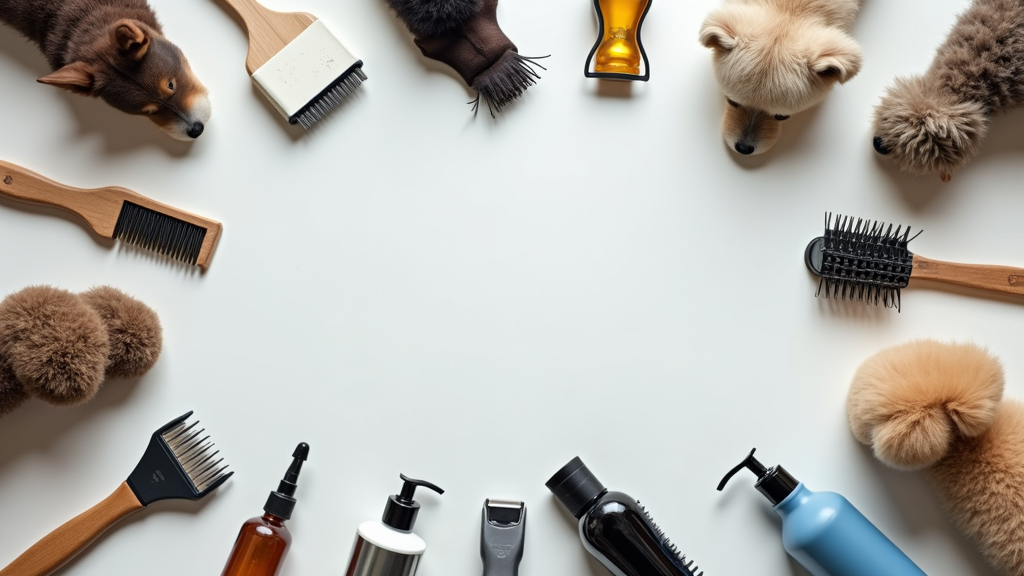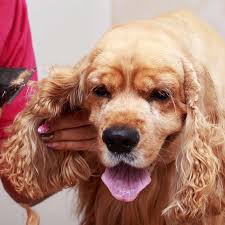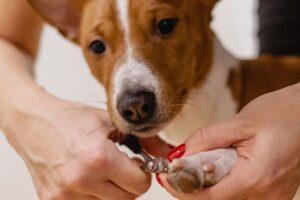Dog grooming guidelines are important for keeping our pets healthy and comfortable. In this article, I share my practical experience and research on how to care for your dog’s coat and overall hygiene at home. I cover essential grooming tools, step-by-step routines, frequency recommendations, and tips to simplify the process. The advice here is based on my experience with various breeds and their unique needs.

Essential Dog Grooming Tools & Their Uses
Maintaining a regular grooming routine can prevent many health issues in your dog. A collection of reliable tools helps keep your dog comfortable and safe. In my experience, using the right tools makes grooming sessions go more smoothly. The essential items include a variety of brushes that suit different coat types, clippers and scissors for trims, specialized shampoos that are gentle on your dog’s skin, and combs that help remove tangles. Grooming wipes and ear cleaning solutions are also useful for everyday maintenance. Choosing tools designed for dogs is very important, as these products meet the specific needs of pet skin and fur.
Using these tools on a regular basis can be extremely helpful, especially when you adapt them to the specific needs of your dog’s breed and coat type. Taking time to understand each tool’s purpose improves your ability to maintain a clean and healthy pet. For example, knowing when to use a slicker brush versus a bristle brush can make your grooming routine more efficient and comfortable for your furry friend.
Step-by-Step Dog Grooming Routine
- Preparation: Begin by setting up a quiet area with all your grooming tools organized on a table. Make sure there is good lighting and a non-slip surface if your dog needs to stand or sit during the process.
- Bathing: Before a thorough brushing, bathe your dog with warm water and a dog-specific shampoo. This removes dirt and loose hair. I make sure the water is at a comfortable temperature and use a rinse method that leaves no irritation on your dog’s skin.
- Brushing: Once the bath is complete, allow time for the coat to loosen up. Use the correct brush based on your dog’s coat type. A careful brush session reduces tangles and mats and promotes a healthier coat.
 Nail Trimming: After drying the coat, check the nail length. Use a sharp clipper and trim small amounts at a time to avoid cutting into the quick. Taking breaks during this step can help keep stress levels down.
Nail Trimming: After drying the coat, check the nail length. Use a sharp clipper and trim small amounts at a time to avoid cutting into the quick. Taking breaks during this step can help keep stress levels down.- Ear Cleaning & Dental Care: Conclude by inspecting the ears for wax build-up and cleaning around them using a dedicated solution. Brushing your dog’s teeth or using dental chews also helps maintain overall health.
This methodical process means you cover all key aspects of grooming while minimizing discomfort. Routine grooming not only supports hygiene but also helps create a bonding experience with your dog.
How Often Should You Groom Your Dog?
The frequency of grooming varies depending on several factors, including breed, coat type, and your pet’s lifestyle. In my experience, dogs with longer coats may require grooming sessions more often than their short-haired counterparts. Some breeds might benefit from weekly brushing, while others may only need monthly maintenance.
If your dog spends a lot of time outdoors, dirt and debris can accumulate faster. This calls for more frequent brushing and occasional baths. Puppies and senior dogs may also require gentle, regular care to prevent skin irritations. Observing your dog’s specific needs allows you to adjust the grooming schedule accordingly.
The Do’s and Don’ts of Home Dog Grooming
Home grooming can be a rewarding experience when done correctly. There are certain practices I follow to ensure a safe grooming session and others I avoid to prevent any harm or discomfort for the dog.
- Do Be Prepared: Have all your grooming tools ready before starting. Ensure that the area is calm, with minimal distractions for your dog.
- Do Use Dog-Specific Products: Always choose products formulated for dogs. Their skin has different sensitivities compared to human skin.
- Do Handle Gently: Be cautious, especially when trimming nails or cleaning ears. A gentle touch reduces anxiety for your pet.
- Don’t Rush the Process: Allow enough time for each step, especially if your dog becomes anxious. Rushing increases the risk of mistakes.
- Don’t Force Your Dog: If your pet becomes highly stressed or restless, break the session into shorter periods or try again later.
- Don’t Overuse Products: Using too much shampoo or cleaning solution can dry out the skin. Follow the manufacturer’s directions closely.
Sticking to these guidelines helps maintain a calm environment for grooming. Familiarizing yourself with the do’s and don’ts goes a long way in building trust with your dog during grooming sessions.
Understanding Your Dog’s Coat Type and How to Groom It
Every breed has a unique coat that requires specific care. I have learned that understanding the characteristics of your dog’s fur can make a big difference in grooming routines.
Long-haired breeds often need regular detangling and brushing to prevent mats. I use a combination of slicker brushes and wide-tooth combs to manage their fur properly. For short-haired dogs, a bristle brush can give a boost to natural oils and lend a healthy shine. Curly or double-coated breeds have special needs as their fur can trap dirt and moisture, which may lead to skin irritations if not groomed regularly.
Assess your dog’s coat to determine the best method. Type-specific grooming techniques ensure that each part of your dog’s fur receives proper attention. Paying close attention to areas like behind the ears and under the legs can help keep them comfortable and looking neat.
Bathing Your Dog: Tips for a Stress-Free Experience
Bath time is a key part of a dog’s grooming routine, and making it enjoyable can reduce stress for both of you. My own experience has taught me that preparation and a calm environment make a big difference.
Choose a time when your dog is less energetic, such as after a walk or playtime. Warm water is essential for comfort, and using a non-slip mat in the tub or shower helps prevent accidental slips. I prefer using a handheld shower head to control the water flow and avoid overwhelming the dog with too much water at once.
Allow your pet to get used to water gradually. Speaking in a calm tone and offering treats during the process can create a positive association with bath time. After the bath, dry your dog with a soft towel and, if necessary, use a pet-specific dryer at a low, comfortable setting.
Brushing Basics: Preventing Mats and Tangles
Regular brushing is important to keep your dog’s coat healthy. I have noticed a marked difference in coat quality when grooming is done consistently. Brushing helps remove loose hair and dirt, and it can prevent the development of painful mats.
Depending on your dog’s coat type, select the appropriate brush. For example, a slicker brush works well on longer fur to gently remove tangles without hurting the skin. For short-haired dogs, a bristle brush can give a boost to natural oils and impart a healthy shine. It is helpful to brush in the direction of hair growth. If there are stubborn tangles, use a detangling spray formulated for dogs. Spending a few extra minutes on this step can avoid issues that might require professional help later on.
Nail Trimming: How to Do It Safely and Avoid Injury
 Nail trimming can be challenging at first, but with practice it becomes easier for both you and your dog. I learned that preparing the right way and taking it slow makes my dog more comfortable during this routine.
Nail trimming can be challenging at first, but with practice it becomes easier for both you and your dog. I learned that preparing the right way and taking it slow makes my dog more comfortable during this routine.
Start by choosing a pair of clippers designed for dogs. These clippers help in making clean cuts without splitting the nail. Hold your dog’s paw firmly and trim a small portion from each nail. If you are uncertain about the length, it is useful to trim a little bit at a time.
Watch out for the quick. The quick is the sensitive area inside the nail that can bleed if cut accidentally. If your dog has dark nails, trimming can be more challenging. In such cases, using clippers with a safety guard or seeking advice from a professional groomer might be wise.
Ear Cleaning & Dental Care: Overlooked but Essential Grooming Steps
Often, pet owners may overlook ear cleaning and dental care during a grooming session. I have found that these steps are critical for preventing infections and maintaining overall health.
Clean your dog’s ears using a solution specifically formulated for dogs. Gently wipe the outer part of the ear with a soft cloth and avoid inserting anything deep into the ear canal. Regular ear cleaning can help spot signs of infection early on.
Dental care is just as important. Brushing your dog’s teeth a few times per week with a dog-friendly toothpaste helps prevent plaque buildup and gum disease. Many dogs benefit from dental chews, which can reduce tartar and freshen breath between brushings.
Professional Grooming vs. DIY: When to Seek Expert Help
Deciding between grooming your dog at home or visiting a professional groomer depends on various factors. I enjoy handling most grooming tasks myself, but I know when it is wise to lean on expert support.
Simple tasks like brushing, bathing, and basic nail trimming can be performed at home with proper care and tools. However, if your dog has a very thick coat, a skin condition, or if home grooming becomes too challenging, professional assistance might be the better choice.
Professional groomers have specialized tools and training to manage even the trickiest grooming challenges. It is worthwhile to consider regular appointments with a groomer, especially during peak shedding seasons or if your pet becomes anxious during home grooming. Combining at-home care with periodic professional help often yields the best results.
Additional Tips and Tricks for a Smooth Grooming Session
To further refine your dog grooming routine, consider incorporating additional tips that can make the entire process more enjoyable and effective. One useful tip is to gradually introduce grooming tools to your dog when they are relaxed, perhaps after a long walk, so that the experience feels like a fun part of the day rather than a chore. Using positive reinforcement, such as gentle praise and small treats, can help your pet associate grooming with good things. It is also a good idea to mix up the routine every so often to keep things interesting and prevent your dog from getting too accustomed to a single pattern that might lead to restlessness. Additionally, spending a little extra time massaging your dog during brushing not only helps distribute natural oils but also deepens the bond between you two. Paying attention to signs of discomfort and adjusting your technique shows that you are responsive to your pet’s needs. Over time, these small changes can add up, making grooming sessions more relaxed, enjoyable, and ultimately beneficial to your dog’s overall health.
Final Thoughts on Dog Grooming Guidelines
Providing proper grooming for your dog is a practical way of ensuring their health and happiness. As I have shared here, organizing the right tools and understanding the detailed steps of a grooming routine can make a big difference. Whether it is maintaining coat health by trying different brushes or carefully trimming nails, every action contributes to your dog’s overall well-being.
The more you understand and adapt your routine based on your dog’s coat type and behavior, the easier grooming becomes for both you and your pet. I encourage pet owners to follow these guidelines and adjust as needed to achieve the best results. Over time, regular grooming fosters a positive experience and builds trust between you and your dog.
While at-home grooming is manageable for many routine tasks, do not hesitate to seek professional help if you notice persistent issues or if your dog becomes too anxious. A balanced approach that combines DIY care with expert advice often leads to the healthiest and happiest pet. Taking the time to research and understand each step in the grooming process has helped me develop a routine that minimizes stress and maximizes effectiveness. I hope these guidelines assist you in building a comfortable and successful grooming routine that benefits your pet’s health and strengthens your bond over time.


I found the detailed guidelines on dog grooming quite thought-provoking, and they’ve sparked some questions based on my own experiences. How do you recommend adapting these grooming techniques for different breeds, especially those with more sensitive skin or unique coat types? I’m also curious about any tips for managing seasonal shedding or reducing stress during grooming sessions. Additionally, are there specific eco-friendly or natural products you’ve seen work best without irritating a dog’s skin?
Thank you for your thoughtful comment! I’m glad you found the guidelines engaging.
When it comes to adapting grooming techniques for different breeds, it’s essential to consider coat type and skin sensitivity—using the right brushes, shampoos, and grooming frequency makes all the difference. For dogs with sensitive skin, hypoallergenic or oatmeal-based shampoos can be soothing.
Managing seasonal shedding often involves regular brushing with the appropriate de-shedding tools and a balanced diet rich in omega-3s.
To reduce stress, positive reinforcement, gentle handling, and short, rewarding grooming sessions can help. As for eco-friendly products, I’ve seen great results with organic aloe-based shampoos and biodegradable wipes. Let me know if you have any specific concerns—I’d be happy to dive deeper!